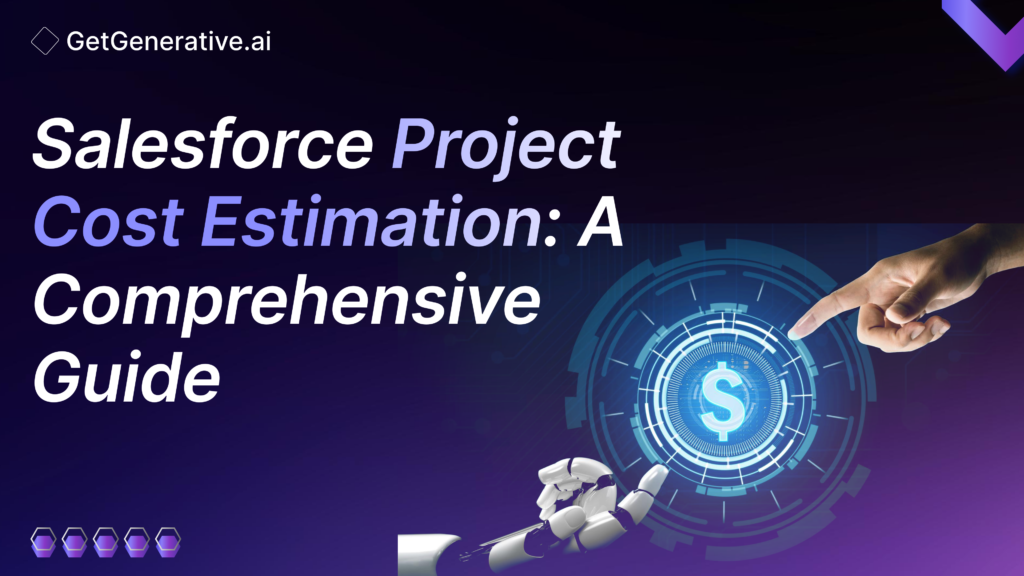Salesforce Project Cost Estimation: A Comprehensive Guide
In the dynamic world of Salesforce implementations, accurate project cost estimation is pivotal. It not only ensures that projects are delivered within budget but also helps in managing resources effectively.
This guide delves into the systematic approach required to master cost estimation for Salesforce projects, ensuring stakeholders are well-informed and budgets are meticulously managed.
Steps Involved in Cost Estimation
1. Requirement Gathering
This initial phase involves collecting crucial project information to fully understand the scope and specific needs of the Salesforce project. Effective requirement gathering is foundational, as it sets the stage for all subsequent planning and estimation processes.
2. Resource Identification
Identifying the right mix of personnel, tools, and technology is essential. This step involves a detailed analysis of the human and technical resources needed to complete the project, ensuring that all necessary capabilities are accounted for.
3. Solution Architecture
Defining the high-level solution and architecture is crucial for visualizing the end state of the project. This involves outlining the system’s structure, functionalities, and the interdependencies that exist within it.
4. Effort Estimation
Estimating the effort involves approximating the amount of work and time required for each component of the project. This is crucial for setting realistic timelines and allocating resources effectively.
5. Cost Calculation
Here, the costs are calculated based on the estimated effort and resources. This step is critical for budget formulation and ensures that all financial resources are accounted for appropriately.
6. Contingency Planning
Including a budget for unexpected expenses is essential for risk mitigation. This step prepares the project for potential overruns and unforeseen costs, safeguarding the project’s financial health.
7. Review and Validation
The final step involves reviewing and validating the estimated costs and plans with all project stakeholders. This ensures that the estimates are accurate and feasible, thereby setting the project up for success.
Key Effort Areas in Salesforce Project Estimation
- Requirement Analysis: Involves gathering and analyzing requirements to ensure all needs are accurately captured.
- Design & Architecture: Focuses on the blueprint and structure of the solution, determining the technical framework and design.
- Testing: Essential for verifying the functionality and performance of the Salesforce solution.
- Development: The actual coding and creation of the Salesforce solution.
- Data Migration: Involves transferring data from existing systems to the new Salesforce platform.
- Integrations: Connecting the Salesforce solution with other systems and software.
- Project Management: Overseeing the project to ensure it meets deadlines, stays on budget, and aligns with client expectations.
- Documentation: Creating detailed documents that outline the use and maintenance of the Salesforce system.
- Stakeholder Management: Engaging with and managing expectations of all parties involved.
- Support & Maintenance: Providing ongoing assistance and updates for the Salesforce solution.
- Training: Educating users on how to effectively utilize the new system.
- Deployment: The process of implementing the Salesforce solution into a live environment.
Also Read – Salesforce Proposals Cheat Sheet
Key Roles in Salesforce Project Estimation
Project Manager
The Project Manager is crucial, overseeing the entire cost estimation process. They ensure accuracy, manage the budget, and are the linchpin in keeping the project aligned with its financial goals.
Consultant
Consultants play a key role in providing detailed, actionable requirements that shape the cost estimation process, ensuring that all estimates are grounded in the project’s practical demands.
Architect
The Architect estimates costs related to the technical design and architecture. Their expertise is crucial in forecasting the technical expenses that will shape the project’s budget.
Finance Team
A dedicated Finance Team reviews cost estimates and provides the necessary financial oversight. This ensures that the project remains financially viable and the estimates are maintained within the budgetary constraints.
Aspects of Solution Estimation
- Scope Definition: Define precisely what will be delivered to prevent scope creep, ensuring all parties have clear expectations.
- Solution Overview Diagrams: Create visual diagrams of the solution architecture to facilitate understanding and communication among stakeholders.
- Detailed Requirements: Break down the project requirements into smaller, manageable tasks for more accurate estimation.
- Feature List: Compile a comprehensive list of all features and functionalities that the solution will offer.
- Complexity Analysis: Evaluate the complexity of each feature to refine the cost and time estimates.
- Technology Stack: Specify the products and additional tools that will be used, ensuring compatibility and efficiency.
- Integration: Plan for the integration of the Salesforce solution with both internal and external systems.
- Effort Estimation per Feature: Estimate the time and resources needed for each feature, helping to allocate budget and resources effectively.
- Configuration vs. Custom Development: Determine whether features require standard configurations or custom development, affecting the project’s complexity and cost.
- Dependencies and Sequencing: Identify any dependencies between tasks and the sequence of development, crucial for project planning and timing.
- Existing vs. Greenfield Implementation: Decide if the solution will integrate with existing systems or if it will be a completely new implementation.
- Functional and Non-Functional Requirements: Consider all requirements, including those related to system performance and security, to ensure the solution is robust and compliant.
Also Read – Salesforce Proposal Creation With AI: Streamline & Win Deals
Project Costing Details
- Resource Costing: Costs for all personnel including developers, analysts, and project managers.
- Contractors vs. Employees: Differentiate costs between contractors and full-time employees, which can impact overall budgeting and cost management.
- Infrastructure Costs: Include expenditures for software licenses, hardware, and cloud services which are crucial for the project’s technical backbone.
- Operational Costs: Cover office space, utilities, and miscellaneous expenses which are often overlooked in initial estimates.
- Contingency Budget: Allocate 10-20% of the budget for unexpected costs and risk mitigation to manage unforeseen expenses effectively.
- Travel and Accommodation: Account for costs associated with on-site visits and regular client meetings which are necessary for project success.
- Training and Support: Include costs for client training and post-implementation support to ensure smooth operation and adoption of the Salesforce solution.
The Role of AI in Salesforce Cost Estimation
As Salesforce projects become more complex, incorporating AI-driven tools for cost estimation is emerging as a game-changer. AI-powered platforms can analyze historical data, predict effort areas, and identify potential risks more accurately than traditional methods. These tools, integrated seamlessly into Salesforce ecosystems, offer benefits such as:
- Improved Accuracy: AI minimizes human error by leveraging large datasets to generate precise estimates.
- Predictive Analytics: Advanced algorithms help foresee potential roadblocks, allowing teams to allocate resources proactively.
- Scenario Modeling: AI tools can simulate different project scenarios, enabling organizations to explore cost-saving strategies before implementation.
- Dynamic Adjustments: Unlike static estimates, AI solutions provide real-time updates as project parameters evolve, ensuring budgets stay on track.
Tips to Reduce Project Costs
- Leverage Standard Configuration: Use built-in options to minimize the need for custom development, reducing time and cost.
- Leverage Prebuilt Components: Reuse existing components to save time and effort, enhancing project efficiency.
- Shared Responsibilities: Assign tasks like data entry and training to the customer to distribute workload and reduce labor costs.
- Consider Offshore Resources: Utilize lower-cost offshore resources for certain development tasks to lower overall project costs.
- Partial Resource Loading: Assign resources part-time to multiple projects to maximize efficiency and reduce idle time.
- Use Agile Methodologies: Implement agile practices to improve project efficiency and adaptability.
- Streamline Communication: Use effective tools and strategies to avoid misunderstandings and delays.
- Monitor and Control Costs: Continuously track and adjust project costs to stay within budget.
- Negotiate Vendor Contracts: Secure better terms and discounts for software and services to reduce expenditure.
- Automate Testing: Implement automated testing to save time on manual tests and speed up the development process.
This comprehensive approach not only helps in estimating costs accurately but also provides actionable strategies to keep costs under control while maintaining project quality and timeliness.
Conclusion
Accurately estimating the costs associated with Salesforce projects is a multifaceted process that requires attention to detail, careful planning, and strategic execution. By understanding the key roles, effort areas, and effective cost-reduction strategies, organizations can ensure that their Salesforce implementations are not only successful but also financially sound.
By following these guidelines, businesses can navigate the complexities of Salesforce projects with confidence, ensuring that they deliver value while maintaining control over their financials.
For more insights and resources, visit GetGenerative.ai and stay updated with the latest in Salesforce solutions and project strategies.




